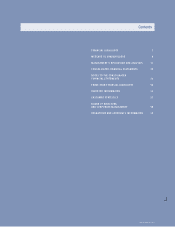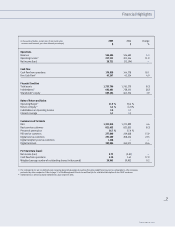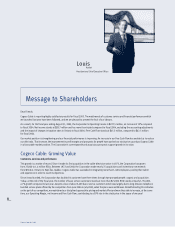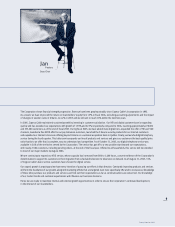Cogeco 2005 Annual Report Download - page 16
Download and view the complete annual report
Please find page 16 of the 2005 Cogeco annual report below. You can navigate through the pages in the report by either clicking on the pages listed below, or by using the keyword search tool below to find specific information within the annual report.
14
Cogeco Cable Inc. 2005
Critical Accounting Policies and Estimates
The preparation of financial statements in accordance with Canadian
GAAP requires management to adopt accounting policies and to
make estimates and assumptions that affect the reported amounts
of assets and liabilities, contingent assets and liabilities, and
revenue and expenses during the reporting year. A summary
of the Corporation’s significant accounting policies is presented
in Note 1 on page 34 of the consolidated financial statements.
The following accounting policies were identified as critical
to Cogeco Cable’s business operations:
Revenue Recognition
The Corporation considers revenue to be earned as services
are rendered, provided that ultimate collection is reasonably
assured. The Corporation earns revenue from several sources.
The recognition of revenue from the principal sources is as follows:
•
Monthly fees from cable television and related services, from
HSI access services and from digital telephony are recognized
when services are provided on a pro rata basis over the month.
•
Since management considers the sale of home terminal devices
as a single unit of accounting of a multiple element arrangement,
equipment revenue are recorded upon activation of the service.
•
Installation revenue is deferred and amortized over the average
life of a customer’s subscription, which is four years. Management
considers that installation revenue is part of a multiple element
arrangement and has no standalone value. Accordingly,
installation revenue is deferred and amortized at the same
pace as cable television, HSI services and digital telephony
monthly fees are earned.
•
Promotional offers are accounted for as a deduction of revenue
when customers are taking advantage of such offer.
Allowance for Doubtful Accounts
A large proportion of the Corporation’s revenue are earned
from individual customers. Accordingly, allowance for doubtful
accounts is calculated by examining such factors as the number
of overdue days of the customer’s balance owing as well as
the customer’s collection history with Cogeco Cable. As a result,
conditions causing fluctuations in the aging of customer accounts
will directly impact the reported amount of bad debt expenses.
Capitalization of Direct Labour and Overhead
As outlined in the recommendations of the Canadian Institute
of Chartered Accountants (CICA) with respect to property, plant
and equipment, capitalization of costs includes the expenditures
to acquire, construct, develop or improve an item of property,
plant or equipment, and includes all costs directly attributable
to those activities. The cost of an item includes direct construction
or software development costs, such as materials and labour,
and overhead costs directly attributable to the construction
or software development activity. The cost to enhance the service
potential of an item is considered an improvement and as a result
is capitalized. Costs incurred in the maintenance of service potential
are expensed.
Cogeco Cable capitalizes direct labour and direct overhead costs
incurred to construct new assets, enhance existing assets and
connect new customers. Although capitalization of financial expense
is permitted for construction activities, it is the Corporation’s policy
not to capitalize them.
Amortization Policies and Useful Lives
Cogeco Cable amortizes fixed assets over the estimated useful
lives of the items. In estimating useful lives, the Corporation
considers such factors as life expectancy of the assets, changing
technologies and cable industry trends. The Corporation reviews
its useful lives estimates on a regular basis. If changes in the
above-mentioned factors happen more quickly than anticipated,
Cogeco Cable might have to shorten the estimated life of certain
assets, which could result in a higher amortization expense
in future periods.
Capitalization of Launch Costs, Costs to Acquire
Customers and Subsidies on Equipment
The Corporation incurs significant marketing costs during the launch
of new services, such as new digital tiers, VOD, HSI and digital
telephony services. These costs are capitalized and amortized over
a period of five years, the estimated period during which these costs
are to provide benefit. Our experience indicates that it takes
approximately five years for the new services to reach a certain
maturity level.
In addition, significant costs are incurred to reconnect customers
and to attract new cable, HSI and digital telephony customers.
These costs include material and labour costs incurred to reconnect
customers as well as subsidies given to customers on the sale
of home terminal devices. Reconnect costs are capitalized up
to a maximum amount not exceeding the revenue generated
by the reconnect activity. These costs are amortized over a period
of four years, which represent the average life of a customer’s
subscription since no term is specified for which the customer will
receive the services. The average life of a customer’s subscription
is reviewed annually and changes could have a significant impact
on the amortization expense.
Management’s Discussion and Analysis
























